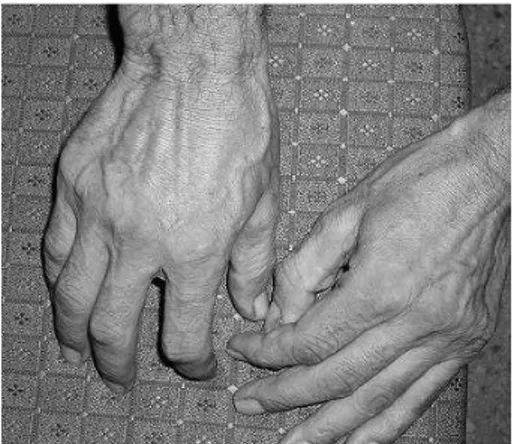Journal of Movement Disorders 2011;4:78-79 pISSN 2005-940X / eISSN 2093-4939
Concomitant Appearance of Pisa Syndrome and
Striatal Hand in Parkinson’s Disease
CASE REPORT
Sanjay Pandey
Manmohan Mehndiratta Department of Neurology, GB Pant Hospital, Delhi, India
Received May 24, 2011
Accepted August 31, 2011 Corresponding author Sanjay Pandey, MD, DM Department of Neurology, RN. 507, GB Pant Hospital, Delhi, India
Tel +9109868598932
Fax +01123234350
E-mail sanjaysgpgi2002@yahoo.co.kr •- The authors have no financial conflicts
of interest.
78 Copyright ©2011 The Korean Movement Disorder Society
Pisa syndrome is (PS) usually seen in patients receiving antipsychotic drugs and character-ised by lateral flexion of trunk and axial dystonia. It is believed that antipsychotic drugs lead to dopamine blockage causing PS. We describe a Parkinson’s disease patient who was doing well with levodopa/carbidopa for 3 years and developed lateral flexion of trunk. His abnor-mal posture used to completely improve upon lying down position. He also had striatal hand deformity suggestive of focal dystonia. Journal of Movement Disorders 2011;4:78-79 Key Words: Pisa syndrome, Parkinson’s disease, Dystonia.
Different types of abnormal postures have been described in Parkinson’s disease (PD). Camptocormia, striatal hand, striatal foot are common manifestations in PD, however Pisa syndrome (PS) has been rarely described.1 PS commonly occurs in subjects receiving anti-psychotic therapy and is characterised by axial dystonia and lateral flexion of body. Rarely this syndrome has also been described in Alzheimer’s disease (AD) and multisystem atro-phy.2 Striatal hand and foot has been reported in approximately 10% of PD subjects. PS and striatal hand both reflect severe type of dystonia and to the best of our knowledge have not been described together in PD.
We describe a patient who had both highlighting a very rare combination of axial and limb dystonia in a subject of PD in early part of the disease without any exposure to dopamine blocking agents.
Case
A 42 year old gentleman presented with rest tremors, bradykinesia and rigidity for 10 years. He never had any symptoms suggestive of autonomic dysfunctions. On examination there was no cognitive decline and cerebellar signs were absent. He was prescribed levodopa/ car-bidopa preparation with trihexphenidyl. He responded very well to the treatment [UPDRS scale (off 40, on 24)]. After three years of onset of the disease, family members noticed that while walking he was having lateral flexion of trunk and was leaning on left side (see video). Along with this he also developed striatal hand (Figure 1). During supine position his trunk posture used to improve completely. He also showed significant improvement in symptoms with levodopa/carbidopa. His abnormal posture was worse during ‘off’ period in compari-son to ‘on’ period. He was never given any typical or atypical neuroleptic agents. X-rays whole spine, MRI brain and paraspinal electromyography (EMG) were normal.
Discussion
This patient of PD was diagnosed to have Pisa syndrome due to lateral flexion and axial dystonia on standing which used to completely improve in supine position. Normal EMG and spine X-rays rule out any other possibilities.
www.e-jmd.org 79 Pisa Syndrome ▐ Pandey S, et al.
lean on one side.3 Exact pathogenesis of PS is still not known. Different hypothesis have been discussed for understanding the mechanism of this syndrome. It is believed that choliner-gic excess in patients of AD receiving cholinesterase inhibi-tor cause PS. In patients of PD it may be possible that striatal dopamine deficiency or imbalance in dopaminergic-choliner-gic level is responsible for PS.4 This imbalance seems to be asy-mmetrical and is responsible for the lateral flexion on one side. Some authors have described improvement in this phe-nomenon following levodopa/carbidopa treatment. Our
pa-tient also had significant improvement in lateral flexion on standing during on period, however striatal hand symptoms showed no response to levodopa/carbidopa. It has been de-scribed that PD subjects in advanced stage of disease (HY III & IV) have more postural abnormality and striatal deformi-ties while our patient manifested in early part of disease (HY IIb).3 Dopa agonists and amantidine has been tried with vari-able response. Neurosurgical interventions like pallidotomy and deep brain stimulation has also been tried in 13 subjects with good results.5
REFERENCES
1. Ashour R, Tintner R, Jankovic J. Striatal deformities of the hand and foot in Parkinson’s disease. Lancet Neurol 2005;4:423-431. 2. Patel S, Tariot PN, Hamill RW. Pisa syndrome without neuroleptic
exposure in a patient with dementia of the Alzheimer type. J Geriatr Psychiatry Neurol 1991;4:48-51.
3. Cannas A, Solla P, Floris G, Tacconi P, Serra A, Piga M, et al. Reversi-ble Pisa syndrome in patients with Parkinson’s disease on dopaminer-gic therapy. J Neurol 2009;256:390-395.
4. Villarejo A, Camacho A, García-Ramos R, Moreno T, Penas M, Juntas R, et al. Cholinergic-dopaminergic imbalance in Pisa syndrome. Clin Neuropharmacol 2003;26:119-121.
5. Umemura A, Oka Y, Ohkita K, Yamawaki T, Yamada K. Effect of sub-thalamic deep brain stimulation on postural abnormality in Parkinson disease. J Neurosurg 2010;112:1283-1288.
